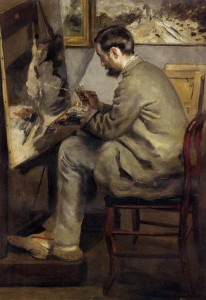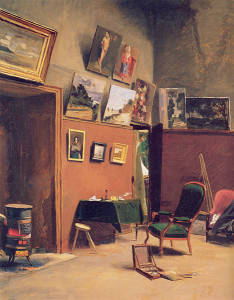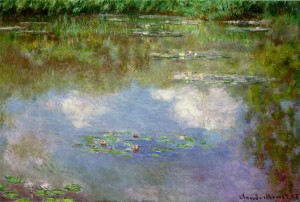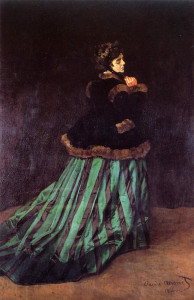Art in Historical Fiction Interview Series featuring Stephanie Cowell
Stephanie Renee dos Santos
 Welcome to week seven of our series. It’s my pleasure to introduce Stephanie Cowell, author of Claude & Camille. Cowell has brilliantly imagined the life story of mid 19th-century French painter Claude Monet, who chose the artist’s life instead of taking over his father’s secure nautical supply business. Against his father’s will, Claude sets off for Paris from his seaside town to pursue his dream of painting. Once in the vibrant city, he confronts an art world that is not ready to accept his new style. He experiences extreme poverty and rejection, but finds enduring friendships and support with fellow artists Renoir, Cézanne, Pissarro, and Manet. Together they form the movement that will become known as The Impressionists.
Welcome to week seven of our series. It’s my pleasure to introduce Stephanie Cowell, author of Claude & Camille. Cowell has brilliantly imagined the life story of mid 19th-century French painter Claude Monet, who chose the artist’s life instead of taking over his father’s secure nautical supply business. Against his father’s will, Claude sets off for Paris from his seaside town to pursue his dream of painting. Once in the vibrant city, he confronts an art world that is not ready to accept his new style. He experiences extreme poverty and rejection, but finds enduring friendships and support with fellow artists Renoir, Cézanne, Pissarro, and Manet. Together they form the movement that will become known as The Impressionists.
Perhaps most importantly, it is in Paris that he meets his lifelong love, Camille Doncieux, a beautiful, upper-class Parisian who forfeits her privileged life to be at the side of the defiant painter, and embraces the Bohemian life. Through extreme hardships and brilliant moments, Claude and Camille navigate life in pursuit of art and love, enduring the defeats and enjoying the triumphant along the way. This is a touching story, revealing the struggles and costs to create and love deeply.
Stephanie Renée dos Santos: What initially intrigued you to pursue 19th-century French painter Claude Monet and his lover’s story in Claude & Camille?
Stephanie Cowell: After I had published my novel about Mozart, my editor had suggested I write a story of someone else in the arts. About that time the Metropolitan Museum in NYC had a major exhibit of the young men who would become The Impressionists; the paintings were mostly from the 1860s when none of them could sell their work. But they were close friends and shared whatever they had – a vase of flowers to paint, studio space, models, a floor to sleep on, even a watch to pawn. I fell in love with their friendship. I also fell deeply in love with some of Monet’s early work from his late 20s, seascapes in particular. I also fell so much in love with the painter Frederic Bazille…. For a long time it was Bazille’s story of his love both for Camille and for Claude.
SRDS: What compelled you to include and focus on art and artists in your historical novel?
SC: It’s the life I know. Almost all my friends are singers, actors, artists, etc. No one in my family or circle ever dreamed of going into medicine, law, teaching, etc. It was only the question of which art you would choose; there just wasn’t anything else. Strange to think back on it! So impractical! And yet so romantic! We were all going to be great stars.
SRDS: What drew you to your specific visual art medium, art works, and artists?
SC: I grew up with art; my father painted in oils and my mother was an illustrator and fashion artist. I went to galleries when I was so small I hardly came to anyone’s waist! I remember looking up and up at some painting through a perfect sea of large people around me. I must have been under six years old. And writing about art can be so visceral: art is messy, it’s full of colors, it’s very physical with stretching canvases and hanging them and sensual with the nudity of the models. Mostly though I am in love with light. I have an incredibly passionate, visceral feeling about light and shadow on buildings, light on new snow and in rainy air. I want to hold it in my hands. I want to grab it and hold it to me. That all went into Claude and Camille.
SRDS: How did you go about incorporating art and artists into the book?
SC: I grew up with studios, as I said, but I am not an artist myself. I read a lot of books on technique and on their lives. I went to Paris. I hung out in art schools and tried to pick up the feelings of the artists, how physical was their desire to paint or draw.
SRDS: Do you have any message you were trying to convey by including art and artists in the novel?
SC: I am fascinated with how great art comes to be, the very messy, haphazard way things happen. The great artists of history had to deal with what we all deal with every day: love and kids and clean socks and bills, but they had in addition something extraordinary….and the amazing thing is, they had no idea how extraordinary it was or what it would be worth. Monet was just a young man who had to paint. It was all a series of strange paths which led him to the water lilies. I am sure he never heard of a water lily when he first began to study art!
SRDS: What story lines do you see as unexplored in this niche of art in fiction?
SC: Oh, there are so many painters and great works of art! There’s so much unexplored, really. I am fascinated by what might have gone on in the two years in which the great Giotto and his assistants were painting the Scrovegni chapel in Padova around 1300. But I have a lot of books going and take a long time to finish them, so likely won’t do this one.
SRDS: What do you think readers can gain by reading stories with art tie-ins?
SC: I hope the world of the artists comes alive for them. So many people have written me that Monet’s work grew much more vivid for them after reading my novel. That is an immense pleasure for me.
SRDS: Why does fiction with art and artists matter?
SC: I think the people who created great works of art are fascinating. What compels someone to do that? What drives them?
SRDS: Are you working on a new historical novel with an art and artists thread? If so, will you please share with us a bit about the upcoming book.
SC: My new novel is about two poets, Elizabeth Barrett and Robert Browning. I have a lot on another one about a woman artist. For some odd reason, I have almost always written the man’s story. It’s just the way things come to me. But I think women have had a harder time finding time to express themselves, especially in previous centuries where their roles were so defined. I think women have a lot of frustration between their need to give to their families and to give as an artist.
SRDS: Any further thoughts on art in fiction you’d like to share or expand on?
SC: Well, I love to read about the desire to create art, how people see things. I think Susan Vreeland’s Luncheon of the Boating Party and Tracy Chevalier’s Girl with a Pearl Earring are so fascinating because they go into the mind and vision of the artist and how that vision draws others into their circle. I don’t think the central story has to be a love story between a man and a woman; the artist’s creation and how it affects everyone around him (or her) is love story enough.
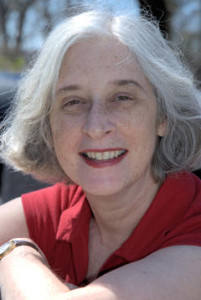 About the author: Stephanie Cowell is the author of Nicholas Cooke, The Physician of London, The Players: a novel of the young Shakespeare, Marrying Mozart and Claude & Camille: a novel of Monet. She is the recipient of an American Book Award; the daughter of artists, she sang for years as a classical high soprano. Her work has been translated into nine languages. Her next novels are about the year Shakespeare wrote Hamlet and the love story of the Brownings. Her website is http://www.stephaniecowell.com.
About the author: Stephanie Cowell is the author of Nicholas Cooke, The Physician of London, The Players: a novel of the young Shakespeare, Marrying Mozart and Claude & Camille: a novel of Monet. She is the recipient of an American Book Award; the daughter of artists, she sang for years as a classical high soprano. Her work has been translated into nine languages. Her next novels are about the year Shakespeare wrote Hamlet and the love story of the Brownings. Her website is http://www.stephaniecowell.com.
Join us here next Saturday July 19th for an interview with Cathy Marie Buchanan, author of The Painted Girls.
Interview posting schedule: May 31st Susan Vreeland, June 7th Mary F. Burns, June 14th Michael Dean, June 21st Donna Morin Russo, June 28th Alana White, July 5th Maryanne O’Hara, July 12th Stephanie Cowell, July 19th Cathy Marie Buchanan, July 26th Alicia Foster
 About the contributor: Stephanie Renée dos Santos is a fiction and freelance writer and leads writing & yoga workshops. She writes features for the Historical Novel Society. Currently, she is working on her first art-related historical novel, CUT FROM THE EARTH. A story of Portuguese tile and its surprising makers – The Great Lisbon Earthquake of 1755 — and the wisdom of nature to guide and heal. www.stephaniereneedossantos.com & Join Facebook group “Love of Art in Fiction“
About the contributor: Stephanie Renée dos Santos is a fiction and freelance writer and leads writing & yoga workshops. She writes features for the Historical Novel Society. Currently, she is working on her first art-related historical novel, CUT FROM THE EARTH. A story of Portuguese tile and its surprising makers – The Great Lisbon Earthquake of 1755 — and the wisdom of nature to guide and heal. www.stephaniereneedossantos.com & Join Facebook group “Love of Art in Fiction“

